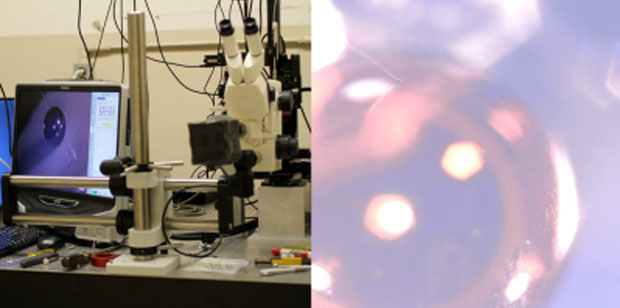Dawn Shaughnessy (16-SI-001)
Project Description
The future of nuclear science lies in the ability to measure nuclear reactions in regimes beyond traditional, low-flux particle accelerators to neutron-rich, high-energy-density plasmas found in astrophysical environments or thermonuclear explosions. The National Ignition Facility (NIF) at Livermore provides a promising opportunity in a unique area of nuclear science that goes beyond low-flux accelerators to bring nuclear reaction research into these high-energy-density plasma environments. A NIF fusion capsule generates temperatures and densities that more closely resemble the interior of massive stars or thermonuclear explosions. We plan to establish an experimental capability at NIF to address research areas of importance to several Laboratory mission areas including neutron-induced reactions on short-lived, excited nuclear states; complex reaction networks and the effects of chemical fractionation in post-shot debris; and charged-particle reactions in a true plasma as a measure of stellar reaction rates. Currently, NIF is the only facility where nuclear reactions can be studied in a high-energy-density plasma environment. These synergistic research areas require development of new methods for adding materials to target capsules, platforms for tailoring neutron outputs, and characterization of debris. The research will be performed in collaboration with various university partners, including University of California, Berkeley, and the University of Notre Dame, and will help attract the next generation of nuclear scientists to address future mission needs.
We expect to provide new methods for adding small amounts of target atoms into hohlraum laser target capsules, including radioactive and nonmetallic species. This will enable us to study the contribution of excited nuclear states to the integrated neutron-activation cross sections relevant to weapon physics. In addition, we will create designs to measure reactions at neutron energies less than a megaelectronvolt. Modeling will be performed through simulations of high-compression capsules and the MCNP model (Monte Carlo n-particle code for neutron, photon, electron, or coupled-particle transport) calculations of moderating materials added to the hohlraum or fielded externally to the capsule assembly. We also intend to examine the debris ejected from a NIF shot to provide quantitative description of any fractionation processes that occur as the debris is distributed. This is crucial to measuring cross sections, especially if corrections must be made to account for debris losses caused by chemical affinity to the collecting medium. Finally, we will extend debris collection at NIF to low-atomic-number, stellar-reaction products through addition of the beryllium-7 radionuclide to the hohlraum exterior to quantify collection efficiency. The final task applies all of the developed platforms to measuring the boron–beryllium reaction as part of a staged approach to ultimately measure the helium–beryllium stellar-reaction rate. All of these platforms will be applied to the measurement of neutron reaction networks highly relevant to stockpile stewardship, nuclear forensics, and nuclear astrophysics.
Mission Relevance
The Laboratory's nuclear, chemical, and isotopic science and technology core competency identifies the need to fill gaps in key nuclear science areas such as plasma nuclear science, fractionation in nuclear decay, nuclear stability, and short-lived nuclei as its primary research priority. Our research project addresses these research areas—calculated evaluations of radiochemistry data often do not match analytical results of post-shot debris analysis because of missing data or incorrect models. These effects can only be quantified through measurements at NIF, and are not possible at other facilities. In addition, our theoretical and experimental research into high-energy-density plasma environments is relevant to the core competency in high-energy-density science.
FY16 Accomplishments and Results
In FY16 we (1) began development of methods for adding materials to NIF capsules—collaboration with target fabricators resulted in several ideas for introducing materials through the fill-tube hole of a capsule (see figure); (2) demonstrated direct inner-surface coating, and gels containing rare earths were cured inside capsules using aerogel precursors; (3) evaluated existing collection data for fractionation; (4) created a complete MCNP model of the NIF chamber and radiochemistry collectors and calculated fluxes; and (5) began investigations on incorporating boron-10 into capsules for astrophysics collaborations with Notre Dame.
Publications and Presentations
- Shaughnessy, D. A., et al., "Nuclear science research with dynamic high energy density plasmas at NIF." J. Phys. Conf. 717, 012080. LLNL-PROC-679522. http://dx.doi.org/10.1088/1742-6596/717/1/012080






